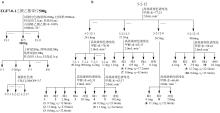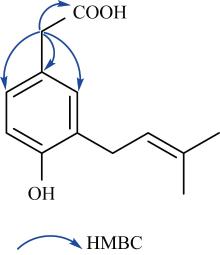Journal of Tropical Oceanography ›› 2023, Vol. 42 ›› Issue (5): 171-177.doi: 10.11978/2022241CSTR: 32234.14.2022241
• Exploitation of Marine Resources • Previous Articles Next Articles
Phenolic acids from soft coral-associated symbiotic and epiphytic fungi Aspergillus sp. EGF7-0-1 (Ⅱ)
FAN Hao1( ), HE Jiahong1, WEI Xia2, CHEN Leyi1, CHEN Xinqi1, ZHANG Cuixain1(
), HE Jiahong1, WEI Xia2, CHEN Leyi1, CHEN Xinqi1, ZHANG Cuixain1( )
)
- 1. School of Pharmaceutical Sciences, Guangzhou University of Chinese Medicine, Guangzhou 510006, China
2. Pharmaceutical college, Guangxi Medicinal University, Nanning 530021, China
-
Received:2022-11-09Revised:2022-11-29Online:2023-09-10Published:2022-12-06 -
Supported by:Special fund of Guangdong Provincial Department of Natural Resources(GDNRC[2021]048); Special fund of Guangdong Provincial Department of Natural Resources(GDNRC[2020]039); National Natural Science Foundation of China(82273845); National Natural Science Foundation of China(81741160); Innovation and Entrepreneurship Program for College Students in Guangdong Province(S202010572122)
Cite this article
FAN Hao, HE Jiahong, WEI Xia, CHEN Leyi, CHEN Xinqi, ZHANG Cuixain. Phenolic acids from soft coral-associated symbiotic and epiphytic fungi Aspergillus sp. EGF7-0-1 (Ⅱ)[J].Journal of Tropical Oceanography, 2023, 42(5): 171-177.
share this article
Add to citation manager EndNote|Reference Manager|ProCite|BibTeX|RefWorks
Tab. 1
Instruments and reagents used in the experiment"
| 仪器/试剂 | 型号/规格 | 品牌 |
|---|---|---|
| 核磁共振波谱仪 | 400MHz AVANCE Ⅲ型 | 德国 Bruker公司 |
| 高分辨液质联用仪 | Triple TOFTM 5600+ | 美国 AB SCIEX公司 |
| 高效液相色谱 | QuikSep半制备型 | 北京慧德易科技有限公司 |
| 旋转蒸发器 | XHRE-2000A | 上海霄汉实业发展有限公司 |
| 低温冷却液循环泵 | DLSB-5/20 | 上海霄汉实业发展有限公司 |
| 单人单面超净工作台 | SW-CJ-1FD | 苏州净化设备厂 |
| 高压蒸汽灭菌器 | LX-B75L型 | 合肥华泰医疗设备有限公司 |
| Kromasil C18半制备柱 | 10mm×250mm, 5μm | 瑞典Akzo Nobel公司 |
| 常规柱层析硅胶 | 200~300目、300~400目 | 青岛海洋化工厂 |
| Sephadex LH-20 | YILIMART 500 G | 瑞典cytiva公司 |
| 乙酸乙酯、甲醇、等常规试剂 | 分析纯 | 广东光华科技股份有限公司 |
| 氘代甲醇 | 25 G | 美国剑桥CIT公司 |
| 葡萄糖 | 分析纯 | 天津致远化学试剂有限公司 |
| 技术琼脂粉 | 分析纯 | 广东环凯微生物科技有限公司 |
| 海盐、大米、土豆 | 市场采购 | |
| 荧光多功能酶标仪 | 美国Beckman Coulter公司 DTX 880 | |
| 噻唑蓝粉末 | 美国Amresco公司 | |
| RPMI-1640培养基 | 美国Gibco公司 | |
| DMEM 培养基 | 武汉普诺赛生命科技有限公司 | |
| 0.25%胰蛋白酶 | 美国Gibco公司 | |
| 胎牛血清 | 上海依科赛生物制品有限公司 | |
| 青-链霉素 | 美国Hyclone公司 |
Tab. 2
1H NMR and 13C NMR data of 1~5 in CD3OD"
| No. | 1 | 2 | 3 | 4 | 5 | ||||||
|---|---|---|---|---|---|---|---|---|---|---|---|
| δH, 裂分 (偶合常数) | δC, 类型 | δH, 裂分 (偶合常数) | δC, 类型 | δH, 裂分 (偶合常数) | δC, 类型 | δH, 裂分 (偶合常数) | δC, 类型 | δH, 裂分 (偶合常数) | δC, 类型 | ||
| 1 | 126.9, C | 126.2, C | 129.0, C | 126.3, C | 123.6, C | ||||||
| 2 | 6.56, m | 132.9, CH | 6.92, m | 131.3, CH | 7.10, d (8.0) | 131.3, CH | 7.07, d (8.1) | 131.3, CH | 7.76, m | 132.5, CH | |
| 3 | 129.2, C | 129.3, C | 6.70, d (8.0) | 116.0, CH | 6.72, d (8.1) | 116.3, CH | 129.0, C | ||||
| 4 | 155.0, C | 155.2, C | 156.9, C | 157.5, C | 160.2, C | ||||||
| 5 | 6.66, dd (8.2, 2.4) | 115.7, CH | 6.88, dd (8.4, 2.5) | 115.9, CH | 6.70, d (8.0) | 116.0, CH | 6.72, d (8.1) | 116.3, CH | 7.69, dd (8.6, 2.0) | 115.2, CH | |
| 6 | 6.67, d (8.2) | 131.3, CH | 6.68, d (8.4) | 131.1, CH | 7.10, d (8.0) | 131.3, CH | 7.07, d (8.1) | 131.3, CH | 6.76, d (8.6) | 130.3, CH | |
| 7 | 3.49, m | 41.6, CH2 | 3.49, m | 41.1, CH2 | 3.69, s | 40.1, CH2 | 3.52, s | 40.9, CH2 | 169.3, C | ||
| 8 | 176.8, C | 177.2, C | 175.7, C | 174.6, C | |||||||
| 9 | 3.78, s | 52.4, CH | 3.65, s | 52.4, q | |||||||
| 1' | 3.07, d (3.3) | 29.2, CH2 | 3.27, d (7.43) | 29.2, CH2 | 3.30, d (1.6) | 29.1, CH2 | |||||
| 2' | 5.07, m | 124.0, CH | 5.30, m | 123.9, CH | 5.32, m | 123.5, CH | |||||
| 3' | 132.9, C | 133.1, C | 133.4, C | ||||||||
| 4' | 17.8, CH3 | 17.8, CH3 | 17.8, CH3 | ||||||||
| 5' | 25.9, CH3 | 25.9, CH3 | 26.0, CH3 | ||||||||
Tab. 3
1H NMR and 13C NMR data of 6~9 in CD3OD"
| No. | 6 | 7 | 8 | 9 | ||||
|---|---|---|---|---|---|---|---|---|
| δH, 裂分(偶合常数) | δC, 类型 | δH, 裂分(偶合常数) | δC, 类型 | δH, 裂分(偶合常数) | δC, 类型 | δH, 裂分(偶合常数) | δC, 类型 | |
| 1 | 122.9, C | 128.9, C | 123.9, C | 6.69, d (8.0) | 123.1, CH | |||
| 2 | 7.63, m | 132.3, CH | 7.71, d (8.1) | 132.3, CH | 7.56, d (8.2) | 131.3, CH | 132.1, C | |
| 3 | 130.1, C | 6.89, d (8.1) | 116.0, CH | 6.66, d (8.2) | 115.9, CH | 7.02, d (8.5) | 116.1, CH | |
| 4 | 163.3, C | 164.3, C | 162.7, C | 156.8, C | ||||
| 5 | 7.59, dd (8.1, 2.1) | 116.0, CH | 6.89, d (8.1) | 116.0, CH | 6.66, d (8.2) | 115.9, CH | 6.72, m | 114.7, CH |
| 6 | 6.89, d (8.1) | 130.5, CH | 7.71, d (8.1) | 132.3, CH | 7.56, d (8.2) | 131.3, CH | 7.02, d (8.5) | 129.2, CH |
| 7 | 9.72, s | 193.1, CH | 9.98, s | 191.1, CH | 165.8, C | 3.51, s | 37.9, CH2 | |
| 8 | 3.79, s | 52.7, CH3 | 176.2, C | |||||
| 9 | ||||||||
| 1' | 3.34, s | 28.9, CH2 | ||||||
| 2' | 5.34, m | 123.0, CH | ||||||
| 3' | 134.0, C | |||||||
| 4' | 17.8, CH3 | |||||||
| 5' | 25.9, CH3 | |||||||
| [1] |
安昶亮, 孔凡栋, 马青云, 等, 2019. 海洋真菌Aspergillus sp. SCS-KFD66的次级代谢产物研究[J]. 中草药, 50(13): 3001-3007.
|
|
|
|
| [2] |
曹雷雷, 天海妍, 王友绍, 等, 2015. 红树植物无瓣海桑果实的化学成分研究[J]. 热带海洋学报, 34(1): 77-82.
|
|
|
|
| [3] |
陈若兰, 黎子洋, 巫惠珍, 等, 2022. 一株红树植物内生真菌Pseudallescheria boydii L32的代谢产物[J]. 中山大学学报(自然科学版), 61(4): 60-64.
|
|
|
|
| [4] |
黎咏怡, 蔡金旋, 方越, 等, 2022. 南海软珊瑚共附生真菌Aspergillus sp. EGF15-0-3中色酮、蒽醌及其二聚体类化合物[J]. 中山大学学报(自然科学版), 61(4): 70-78.
|
|
|
|
| [5] |
刘炳新, 韦霞, 肖细姬, 等, 2021. 南海软珊瑚共附生真菌 Aspergillus sp. EGF15-0-3苯甲醛类化合物研究[J]. 热带海洋学报, 40(4): 63-69.
doi: 10.11978/2020085 |
|
|
|
| [6] |
吕海宁, 陈辉, 屈晶, 等, 2015. 内生真菌Trichoderma harzianum次生代谢产物研究[J]. 中国现代中药, 17(5): 427-430.
|
|
|
|
| [7] |
马丽丽, 田新朋, 李桂菊, 等, 2021. 海洋微生物来源天然产物研究现状与态势[J]. 热带海洋学报, 40(5): 134-146.
doi: 10.11978/2020104 |
|
doi: 10.11978/2020104 |
|
| [8] |
温建辉, 倪付勇, 赵祎武, 等, 2015. 山银花化学成分研究[J]. 中草药, 46(13): 1883-1886.
|
|
|
|
| [9] |
张树军, 刘焕, 李军, 等, 2015. 蒙古苍耳全草化学成分研究[J]. 中草药, 46(3): 329-333.
|
|
|
|
| [10] |
doi: 10.1016/S0040-4039(01)89868-3 |
| [11] |
doi: 10.1039/d0np00089b pmid: 33570537 |
| [12] |
doi: 10.3390/md20070443 |
| [13] |
doi: 10.1021/np500324b |
| [14] |
doi: 10.3390/md20030211 |
| [15] |
doi: 10.3389/fphar.2021.700573 |
| [1] | ZENG Buyan, LIANG Zhifeng, LUO Qinqin, ZENG Ling, YANG Changgeng, WANG Liyun, SUN Yulin. Molecular identification, secondary metabolites and biological activities of a deep-sea-derived fungus 101#* [J]. Journal of Tropical Oceanography, 2023, 42(5): 104-114. |
| [2] | LU Tianmei, GUAN jiasong, QIN Shijing, LIU Yonghong, SU Zhiwei. Preliminary study on the culturable myxobacteria resources from the Beibu Gulf, Guangxi and their antibacterial activity [J]. Journal of Tropical Oceanography, 2023, 42(3): 158-168. |
| [3] | LI Ruofei, KE Zhixin, LI Kaizhi, LIU Jiaxin, TAN Yehui. Vertical distribution of zooplankton in the “Haima” cold seep region based on ZooScan image analysis [J]. Journal of Tropical Oceanography, 2023, 42(2): 87-96. |
| [4] | JIANG Xun, WU Wen, SONG Dehai. Identification and quantitative analysis of key controlling factors of water quality response to human activities in the Daya Bay, China [J]. Journal of Tropical Oceanography, 2023, 42(1): 182-191. |
| [5] | CONG Mengjing, HU Yiwei, ZHAO Kai, ZHANG Xiaoyong, LIU Yonghong, WANG Junfeng. Study on the polyketides from a cold-seep-derived Talaromyces helicus SCSIO41311 [J]. Journal of Tropical Oceanography, 2022, 41(5): 117-120. |
| [6] | GUO Jian, QIU Xuelin, LI Zizheng, HUANG Haibo. Data processing and phase identification of OBS2019-2 in Nansha Block* [J]. Journal of Tropical Oceanography, 2022, 41(5): 43-56. |
| [7] | YIN Tianqi, WANG Qing, YANG Yufeng, CEN Jingyi. Comparative study on zooplankton community structure in Pearl River Estuary based on morphological and DNA identification [J]. Journal of Tropical Oceanography, 2022, 41(3): 172-185. |
| [8] | SONG Ruiyou, YU Junfeng, CHAO Caixia, SONG Peng, PAN Guangchao. Fracture identification technique and its application in gas and hydrate exploration [J]. Journal of Tropical Oceanography, 2020, 39(1): 120-129. |
| [9] | Xiji XIAO,Yun DENG,Lufeng XIE,Qi ZHANG,Xia WEI,Xin YU,Cuixian ZHANG. Research on Sterols from Leptogorgia rigida [J]. Journal of Tropical Oceanography, 2019, 38(4): 64-69. |
| [10] | Jian WANG, Minghui ZHAO, Jiazheng ZHANG, Enyuan HE, Xuelin QIU. The importance of seafloor topographic correction in identifying and picking seismic phases of OBS [J]. Journal of Tropical Oceanography, 2017, 36(5): 93-100. |
| [11] | Jiannan SUN, Ying LIU, Weitian XIE, Chunhou XU. Isolation and identification of marine Rhodotorula in a coastal area near Leizhou Peninsula [J]. Journal of Tropical Oceanography, 2017, 36(4): 87-92. |
| [12] | QI Jiang-hao, ZHANG Xun-hua, WU Zhi-qiang, QIU Xue-lin, ZHAO Ming-hui, XIA Shao-hong, GUO Xing-wei, HAO Tian-yao, ZHENG Yan-peng, FANG Nian-qiao. Preliminary results of the South Yellow Sea OBS 2013 onshore-offshore joint deep seismic survey [J]. Journal of Tropical Oceanography, 2015, 34(2): 76-84. |
| [13] | CAO Lei-lei1, 2, TIAN Hai-yan2, WANG You -shao3, ZHOU Xue-feng1, JIANG Ren-wang2, LIU Yong-hong1. Chemical constituents in the fruits of mangrove plant Sonneratia apetala Buch. Ham. [J]. Journal of Tropical Oceanography, 2015, 34(1): 77-82. |
| [14] | WANG Shu-ying, SHI Wei, JIANG Jin-xia, MIAO Xian-guang, WANG Zhong-ming, KONG Xiao-yu. Applicability of mitochondrial COⅠ and 16S rRNA gene sequences in species identification of sole fish (Pleuronectiformes: Soleidae) [J]. Journal of Tropical Oceanography, 2014, 33(3): 57-65. |
| [15] | GONG Biao, HUANG Wei-gen, CHEN Peng. Ship wake automatic identification algorithm in ASAR image based on improved Hough transform [J]. Journal of Tropical Oceanography, 2014, 33(3): 33-39. |
|
||







